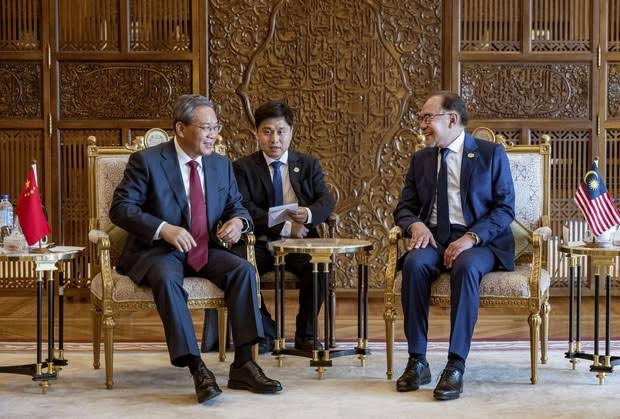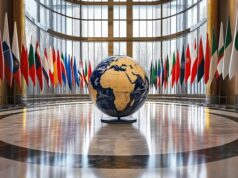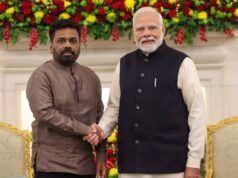Malaysia becomes BRICS partnership member

Malaysian Prime Minister Anwar Ibrahim, right, meets Chinese Premier Li Qiang, left, in Putrajaya, Malaysia, on June 19, 2024
Malaysia and eight other nations officially became partner countries of the BRICS emerging nations grouping this month after the Southeast Asian nation filed its bid last July to join the 10-member economic bloc formed in2009 by Brazil, Russia, India and China as founder members.
Later it expanded to include South Africa, with Egypt, Ethiopia, Iran and the United Arab Emirates joining last year. Now this year Indonesia has joined as the 10th member.
Although Malaysia’s bid for full membership was preceded by Indonesia, the country is still one step away from formally joining the grouping as a full member.
Malaysia’s application could be seen as a move to be fully integrated with Asian economies. It is aiming to boost economic engagement with member countries of the BRICS bloc. The move will help not only Malaysia but also ASEAN as a whole. Malaysian Prime Minister Anwar Ibrahim said earlier this month in Britain that he is trying to position his country “as a vital nexus of trade and investment” in an “unpredictable world.”
“It is through this forward-looking and holistic paradigm that Malaysia came to the strategic decision to join BRICS,” Anwar said.
Though Group of 7 countries may already be panicking because Malaysia also maintains close trade ties with the Group of Seven nations. Anwar, the leader of the Muslim-majority Malaysia, has been outspoken in his criticism of the West. He has labelled the weapons support provided to Israel for its conflict in Gaza hypocritical when Russia is being targeted with punitive actions, including sanctions, in response to its conflict with Ukraine.
So Malaysia becoming partner has raised doubts in G7 countries about whether the country is pivoting further away from the United States and Europe.
Malaysia enjoys very stable relationship with neighbour India. It also has stable ties with China, despite their conflicting claims over territory in the Natuna Sea, while the Philippines has clashed with Beijing over a similar dispute.
Anwar and Chinese Premier Li Qiang met in June, agreeing to recommit to bilateral discussions on the competing maritime claims.
Qarrem Kassim, an analyst with the Institute of Strategic and International Studies in Malaysia, said the notion of Malaysia’s shift from the West to BRICS “oversimplifies its broader strategic approach,” pointing out that the country is party to the U.S.-led Indo-Pacific Economic Framework.
“Malaysia continues to position itself as a neutral and reliable partner for the United States’ and the EU’s semiconductor and high-tech investments,” he said.
The United States and the European Union are Malaysia’s third- and fourth-largest trading partners, behind the Association of Southeast Asian Nations as well as China, with the value of their trade amounting to 250.25 billion ringgit ($57.2 billion) and 206.69 billion ringgit, respectively, in 2023, according to Malaysia’s trade ministry.
“In an increasingly multipolar world, countries that adopt a neutral stance in global power dynamics are better positioned to attract trade and investment from a diverse range of partners,” said Qarrem.
Samirul Ariff Othman, senior consultant with Global Asia Consulting, said in an article published by Malaysia’s New Straits Times in October that BRICS gives Southeast Asian nations “the chance to secure trade deals outside the dollar’s shadow.”
Yet there is curiosity about how BRICS can perform as a counterweight to West in the political and economic arena, including by reducing the dependence on the U.S. dollar and the dominant SWIFT international payment system.
“Countries like Russia and Iran prioritize initiatives such as alternative settlement systems to mitigate the impact of U.S. sanctions on trade,” Qarrem said.
Both nations face varying degrees of exclusion from SWIFT, with major Russian banks banned as part of sanctions over the war in Ukraine.
India and Brazil, which maintain strong economic ties with both Western and non-Western nations, do not view alternative systems as a priority, he added.
India has already gone for trade payments in bilateral currencies with a few countries. Meanwhile, Samirul wrote that technological innovations can provide a way to bypass the dollar in international transactions but the process of “de-dollarization” will be gradual as global financial institutions trust the dollar’s stability.
In November, before taking office for the second time, Trump threatened to impose 100 percent tariffs on BRICS members if they attempt to ditch the dollar for another currency.
Malaysia is among several Southeast Asian countries that were slapped with tariffs by the United States for dumping solar panels produced by Chinese-owned companies.
Given this reality, some Malaysian businesses doubt whether Anwar’s bid to join BRICS is worth the cost. Though BRICS countries accounted for 17.2 percent of Malaysia’s exports in 2023, compared with 21.2 percent to the G7 countries.
However with Indonesia joining as full member these figures must have narrowed down further.
Now Malaysia has huge potential of greater access to trade and investment given that BRICS plus member countries account for over 41 % of the world’s GDP and trade compared to less than 30% for G7.




